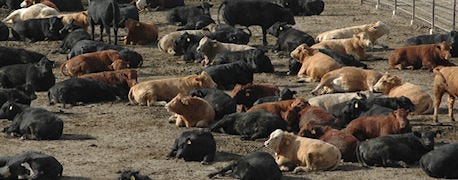September 10, 2013

Though 2013 is likely another year of beef cow herd liquidation, the improvement in conditions in the second half of the year may provide a period of stabilization that often occurs in the first year of herd expansion, according to Derrell Peel, Oklahoma State University Cooperative Extension livestock marketing specialist.
"As long as drought conditions continue to moderate the situation, beef cow herd growth of 2% is possible in 2014 with an additional 2% to 3% in 2015," Peel said.
More rapid growth is unlikely when all factors are considered. Among several implications, Peel believes, is an approximately 7% decrease in total cattle slaughter in 2014.
A historical context

Herd liquidation will likely continue, but historical look at beef cattle markets shows potential for recovery in 2014-2015
Historically, the cattle cycles observed by the beef industry have been largely self-regulating cycles of inventory driven by internal factors such as calf price levels, beef cattle biology and the availability and quality of forage resources.
However, much of the beef cow herd liquidation that has occurred since 2001 – including the aborted herd expansion of 2004 and 2005 – were the result of external factors, including input market shocks that reduced cow-calf profitability, a national and global recession that tempered cattle prices and severe drought in important cattle-producing states.
"The last 3.4 million head decline in the beef cow herd was not due to typical cattle cycle factors," Peel said. "External factors have masked and overwhelmed cyclical tendencies and don't necessarily mean the cattle cycle is gone or irrelevant, although some people have said so."
In situations where drought has forced inventory adjustments that are counter to what producers want to do, the details of how the adjustments happen become vitally important, Peel stresses. In short, how the industry got to where it is will have a significant effect on how beef herd expansion will take place in the future.
~~~PAGE_BREAK_HERE~~~
Since 2007, the calculated number of heifers entering the cow herd has remained above average, even while the high rate of cow culling has resulted in net liquidation and reduction in the cow herd inventory.
"In a more typical cattle cycle, the rate of heifer placement decreases at the same time as increased cow culling, with both contributing to herd liquidation," Peel said.
This very thing happened during the 1996-2001 period of cattle inventory liquidation, as an example. In contrast, heifer placement typically increases simultaneously with decreased cow culling during herd expansion, as was the case from 1991-1995.
"In recent years, producers have continued to invest in replacement heifers despite the necessity of reducing herd size because of external factors," Peel said. "That the industry has simultaneously increased cow culling and heifer placements in recent years means the beef cow herd is not only the smallest in 60 years but likely one of the youngest and most productive ever."
Cow-calf producers appear to have a growing incentive for herd expansion given strong profit prospects and improved forage conditions in many regions of the United States. Beef cow slaughter for the year to date decreased 13% in the most recent two weeks of data available.
"This suggests the beef industry may be back on track of decreasing cow slaughter, a necessary component of herd expansion," Peel said. "However, sharply decreased beef slaughter of 8% to 12% for the remainder of the year will result in an annual beef cow slaughter decline in the modest 4% to 5% range."
Additionally, there are indications replacement heifers were diverted into feeder markets during the first half of 2013, attributed to the residual effects of drought, reduced hay supplies and extended winter weather across areas of the United States.
Peel said the combination of larger cow slaughter – resulting in smaller than projected reductions – and decreased heifer placements is likely to result in a year-over-year decrease of 0.75% to 1.25% in the beef cow herd as of Jan. 1, 2014.
~~~PAGE_BREAK_HERE~~~
"There are indications heifer retention will accelerate this fall with cow-calf producers holding more heifer calves for breeding," he said.
Future still uncertain
Still, cattle industry professionals can be forgiven for scratching their heads when trying to analyze what is coming. Herd expansion prospects for 2014 include factors that suggest both potential for faster-than-normal growth and factors that will limit growth.
The young and productive base herd suggests the potential for one or two years of minimal cow culling, and that could contribute to faster growth," Peel said. "A year-over-year decline in beef cow slaughter of approximately 20% in 2014 would correspond to a culling rate of less than 9%, a low rate for typical herd expansion."
Given the youth of the U.S. beef cow herd, an ever more significant decrease in cow culling is possible – less than 8% – but such a large decrease in cow slaughter might result in a disruption of lean beef supplies.
"The sharply higher cull cow prices that would result should mitigate some of the decrease in cow slaughter," Peel said. "At the same time, significantly more replacement heifers may be reported in Jan. 1, 2014, but the report likely will include a higher-than-normal percentage of heifer calves that will not produce a calf until 2015."
You May Also Like




